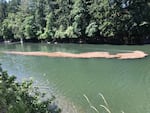When Cottage Grove's public works director heard about the water crisis in Salem, he met with the city's water production superintendent and asked what Cottage Grove was doing to make sure its drinking water was safe from harmful toxins caused by algae blooms.
Related: As Salem Frets About Toxic Algae, Should The Rest Of Oregon?
The Dorena Reservoir has had algae blooms in the past. It flows downstream and into the river where Cottage Grove gets its water. Such blooms produced toxins in the Detroit Lake that reached Salem's drinking water. It's believed to have been the first time cyanotoxins reached a state public water system.
"I said that on Monday we should start our own visual inspections for algae blooms," said Faye Stewart, Cottage Grove's public works director. "And if they're present, we have to have them tested."
Hypothetically speaking, Stewart said that if he hadn't gone out and asked his employees to check for algae blooms, the city wouldn't have known that, sure enough, there was an algae bloom in the Dorena Reservoir.
That prompted city officials to test for toxins near the city's water intake system.
On Wednesday, the Oregon Health Authority issued a recreational health advisory for the reservoir, advising people not to come in contact with the water.
"We instituted some higher protocols and went out on our own because we didn’t want to be in a situation we couldn’t deal with," Stewart said.

An algae bloom in the Dorena Reservoir prompted the Oregon Health Authority to issue a recreational health advisory Wednesday.
City of Cottage Grove Public Works Department
It's yet another discovery made possible by a city's voluntary examination of its water supply chain. Salem discovered cyanotoxins in its drinking water because it conducts voluntary, routine testing that's not required under the federal Safe Drinking Water Act.
Dorena Lakes are operated by the U.S. Army Corps of Engineers as part of a system of 13 multi-purpose dams and reservoirs that make up the Willamette Valley Project, not the city of Cottage Grove.
Currently, there is no statewide monitoring system for algae blooms.
"In Oregon, monitoring for cyanobacterial blooms on recreational waters is done by whichever agency or organization manages the waterbody on a voluntary basis," said Jonathan Modie, communications officer with the OHA. "Monitoring for recreational purposes is not required by law or rule, and waterbody management agencies and organizations decide whether to test, how often to test, and where to test."
The OHA recently announced it's developing new rules that will require testing at drinking water systems in the state that use certain surface water sources prone to algae blooms.
"We have a first list of drinking water systems that we're looking at — about 40 — as they draw drinking water from surface water sources that have had some sort of algae issue in the past," Modie said.
Cottage Grove's water has so far checked clear for cyanotoxins, though Stewart said the city is looking at alternative options in case an advisory is required.
The city's water system serves anywhere between 10,000-12,000 Cottage Grove residents. Stewart said a well in town could produce 250,000 gallons of water a day, though it hasn't been used in close to 12 years. Currently, the city produces more than a million gallons of water a day.
"That supply wouldn't meet all our needs but it could meet our critical needs," Stewart said.